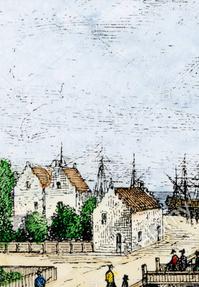The Fulkerson Family Pages
INDIAN TROUBLE
Dirck was one of the few Brooklyn property owners who actually improved their properties in the early years. It is said that the Indians came back to him each year, asking for more money, because the land had increased in value. His improvements suffered some setbacks in the Indian uprisings of 1643 and 1655, when fields were destroyed and homes and barns were burned. Indians killed two of his sons-in-law, Jan H. Schutt in 1652; Cornelis Hendricksen Van Dort in 1655; and, for eight days in 1659, tortured a third, Herman Hendricksen Rosenkranz.
The Founding of Bushwick
Another significant development occurred in 1638 - the Indians agreed to allow Dutch settlement in Brooklyn. Dirck was one of the first to take advantage of the newly-available lands, receiving a grant to buy 400-500 acres of land at Greenpoint from the Indians.
The tract Dirck chose had a mile-long frontage on the East River and had nearly the same frontage on the two tidal streams that bounded his land on the south and north sides, Norman Kill and Mespath Kill. (The Dutch called streams or creeks "kills").
Mespath Kill became Newtown Creek after the British moved into the area and founded the Newtown settlement. Noorman's Kill later became Bushwick Creek.
The inlet where the creek emptied into the East River, immediately south of Dirck's house, still exists today.
Norman Avenue is named for Dirck de Noorman. The northwest point on his East River frontage was known by several names, including Noorman's Point and Woud Hoek (Woodland Point). Years later it was planted with green wheat fields and gained its current name of Greenpoint.
Several other Scandinavians are linked to Dirck in connection with a property he owned, first in vouching for his ownership of the land, and second in buying it from him.
Our Grandfather Dirck was listed third on the charter of incorporation for the town of Boswyck (Bushwick) which was founded with 22 families (mostly French Walloons) in 1655. The town was on the southern border of his property. In 1662 Grandfather Dirck and some other landowners petitioned the authorities to have a road made to their properties. Dirck gave some land to the town, probably for the right of way and in payment for the road. In 1663 he served some role with the town's militia, and in 1664 he was Superintendent of Fencing (the wooden palisades surrounding the village for protection against Indian attacks).
Following the British invasion and occupation of 1664, when New Amsterdam became New York, a royal patent was issued in 1667 to confirm the establishment of "Boswick" and to name the principal founders:
NYHM: "Book of Patents," VII:370, [issued under the authority of] "Anne by the Grace of God of Great Brittain France & Ireland Queen."
Richard Nicolls Esqr Govor Genall and undr his Late Royall Highnesse James Duke of Yorke and Albany of all his Territories in America HATH by Patent undr his hand and Seale Bearing date the Twenty fifth day of Octor one Thousand Six hundred Sixty Seaven given granted ratified & confirmed unto Peter Jansen, Derick Norman, Paulus Richards, David Yoakims & Long Gysbert as Pattentees for and on Behalfe of themselves & their associates the freeholders and Inhabitants of a certain Town Scituate Lyeing & Being in the west Rideing of York Shire now Kings County on Long Island commonly called or knowne by the name of Boswick ALL that the Township of Boswjck aforesd & all the Lands thereunto adjoining & Belonging within the Bounds and Limites herein after particularly exprest …
Dirck and most of his heirs settled down at Bushwick. Most of his grandchildren were born there.
Bushwick on Long Island, New York, is demarcated on modern maps as lying just east of the Broadway Triangle and just west of The Evergreens Cemetery, bounded by Broadway on the western edge, Flushing Avenue along the northern edge, Cypress Avenue along the north eastern edge, almost to Jamaica Avenue on the southern edge.
One historian states that "Dirck naturally contributed in the layout of the village, and in the construction of the buildings, the docks at the waterways, the roads and highly important palisade." Also noted were Dirck's "lore in Indian warfare" and "the stimulation of his belligerent personality in creating courage and initiative in those fellow settlers who had but recently arrived from European countries....he must be considered to have been one of the three outstanding personalities in the history of the town of Boswyck. He became its patriarch. He was its oldest constituent." Dirck paid taxes to the town of Boswyck in 1675, and to New York in 1677. He died about 1678 or 1680, and was probably buried on his farm.
Located at 7 N 15th St, Brooklyn, NY 11222, in a former plastic bag factory with large windows looking out over Bushwick Inlet and the East River waterfront, Dirck the Norseman, named for our great, great, great, great...grandfather, was opened by Ed Raven in the spring of 2014 and was named "for a 17th-century Scandinavian shipbuilder who acquired 300 acres of what is now Greenpoint and Bushwick." Publicity notices and customer reviews (most of which are good) may still be found online.
In addition to crafting its own beers, Dirck the Norseman, the microbrewery served chicken schnitzel and "Dirck sausage."
By the end of 2015, the brewpub owners decided to change the name of the establishment to Greenpoint Beer and Ale. While Dirck's former farmland was a fine spot to locate a business, apparently, his name hasn't sold restaurant fare and beers all that well!
For a pronunciation guide to many of the Dutch names of people and places in the New Netherlands settlement, visit the wonderful site of Mr. Marco Schuffelen, Hear Dutch Here.
Be sure your speakers are on! There are also many lovely photographs on Mr. Schuffelen's site.
Click here to read about the Household of Dirck Holgerson de Noorman and Christine Vigne.






